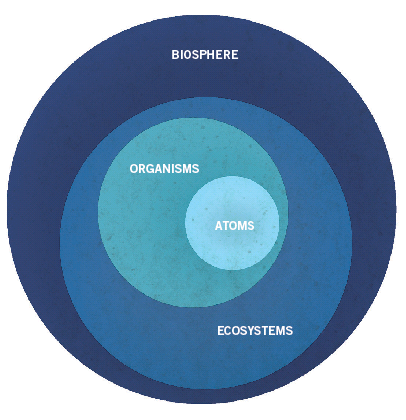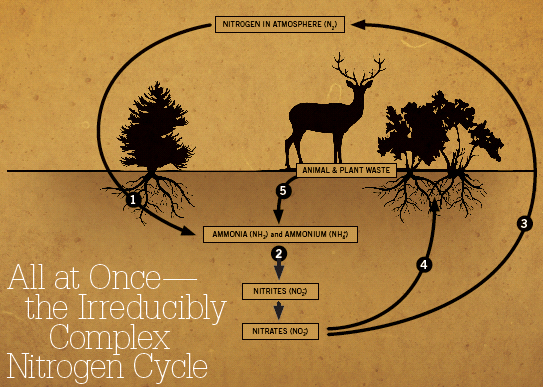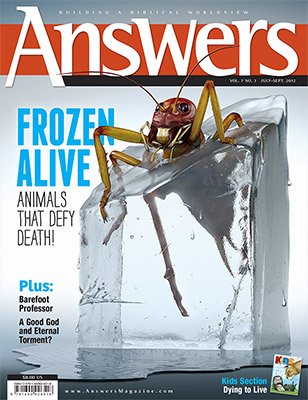Seeing the Forest amid the Trees
The Web of Life
In our modern, urbane, scientific world, we assume that the debate about creation can be settled only under microscopes by scientists peering at DNA molecules and tissues. Not so. The Creator’s wondrous design can be seen not just in individual organisms but in the whole, interdependent relationships—the ecosystems—that support life.
Darkness settled around us as we made our way down the forest path. The students’ fear was tangible. They clung to each other as if their lives depended on it, while nervous laughter sporadically escaped their lips. One or two struggled not to bolt to the safety of the cabins.
I was teaching a high-school class on the ecology of New York’s Adirondack Mountains, with an emphasis on mammals. The project list included some hands-on work in the forest at night, but my students admitted they were deathly afraid of the dark. So to quiet their fears, I offered to lead a night hike and introduce them to the forest as few had experienced it. They agreed, reluctantly leaving their flashlights behind.
Our journey into ecology—as the Creator intended us to experience it—began.
The Myth of the Lone Ranger
As we learn more about the world, it is becoming clear that nothing lives alone. All life needs other living things. Relationships are prevalent on the earth.
This makes sense for those who hold a biblical worldview. The Father, Son, and Holy Spirit have always existed in an intimate, loving relationship. So relationships are timeless. If God is relational within the essence of His being, it stands to reason that He would display this relational attribute everywhere in His creation (Romans 1:20).
Ecology is the study of relationships. Through it we catalogue and explain how organisms relate with each other and with their nonliving environments. Ecosystems are the places where these relationships flourish, including both the living and nonliving elements of the environment.
These relationships express themselves in many ways, such as the division of labor in each ecosystem. Each organism contributes what are called ecological services, providing essential food or clean water, regulating chemicals or temperature, and otherwise supporting the health of nearby creatures. The ways these duties are efficiently divided seem intentionally designed, and every creature has an important role in the whole ecosystem.
I wanted my students to see this interdependence firsthand. It has far-reaching implications. For example, past attempts to protect endangered species often failed because many ecologists were trained to see the world as a violent “dog-eat-dog” contest for survival. They focused on the individual species rather than their vital relationships to all the other species in the ecosystem. (When California condors were bred and re-released into the wild in the early 1990s, researchers failed to realize that humans had altered their habitat so that the birds no longer had enough space, and many died. Today the condors are making a slow comeback due, in part, to humans’ setting aside large, unfragmented ecosystems that provide the relationships condors need for survival.)
The more we understand about the important services that each organism provides, the clearer it becomes that the only way to protect endangered species is to consider the whole environment (with its corresponding organism services).
Research in ecology shows that in many cases the interdependency of creatures is critical for the life and survival of each living organism. This interdependency is inconsistent with the belief that ecological relationships developed gradually over millions of years. But it is consistent with the Bible’s revelation that God created all living organisms in only six days.
Organisms Need One Another
Inching down the dark trail, my timid entourage found a large tree and sat at its base. We remained silent and let the sounds and smells of the forest engulf us. Suddenly, blood-curdling screams echoed from high atop the tree. I tried to calm the terrified students, assuring them we were not witnesses to a murder. Rather, the screams came from baby owls who wanted Mama to feed their empty stomachs.
This tree was home to a family of barred owls. Not only did the tree provide a home for these marvelous creatures, it provided other invaluable services, such as oxygen, water, food, soil stability, fertilizer, and shade. Trees even regulate the climate.
Yet trees depend on the services of others, too, if they are to thrive. They need carbon dioxide from the respiration of owls and other forest creatures. They also need their help with pest control, pollination, and seed dispersion. Trees even need the help of fungi, which partner with them to provide their roots with nutrients and water. Owls and trees are intricately connected to each other along with a diverse array of other creatures.
We quietly left the baby owls with their mama and continued slowly down the path. Thirty minutes later, the trail wound its way to the shore of a lake, fed by a little stream. With the forest behind us and the lake before us, a rush of sights, sounds, and smells overwhelmed our senses. Gazing heavenward, we saw pinpricks of starlight everywhere. Along the shore, blinking lights from hundreds of fireflies floated and danced. Feeding fish escaped the confines of their watery home and leaped into the air. Bullfrogs joined in a mating chorus. As we sat and absorbed the scene, there was much to contemplate in God’s creation.
I noticed a change in the group. Relations with each other were growing, trust was building, fear was dissipating, and bonds were forming. I also felt the growing awe in each student as they considered the immensity and diversity of the beauty that surrounded us.
Designed to Work Together
God’s creation is an amazing gift. The more I understand it, the more insight and appreciation I have for my heavenly Father. Not only are living creatures bound to each other by their mutual services, but they also share common needs that God supplies in other ways.
Lakes and streams, for example, are an integral part of the water cycle, providing the fresh water needed for the body functions of all animals. The system recycles and purifies water with the help of a wide range of creatures and filtering materials, such as bacteria, plants, and soil.
And that’s just one example. Connected to the water cycle is the phosphorus cycle. Phosphorous is an essential element that all biological life—from bacteria and plants to frogs and humans—needs. Phosphorus is a building block of DNA and cell membranes, necessary for energy, growth, and reproduction. It is even essential for lighting a firefly’s lantern.
But in its original rock form, phosphorus is unusable. It must first be combined into a compound called phosphate (PO4-3). So God designed an intricate system to make this nutrient available to living things. As water cycles around the planet, it dissolves phosphate and washes this vital nutrient into soils and bodies of water. There the phosphate gets absorbed by plants and algae.
Plants are another essential contributor to life. As manufacturers and distributors of essential nutrients, plants are the basis, in one sense, for the survival of everything else. Trees and other plants drop leaves and branches onto the ground or directly into a stream or lake. Fungi and bacteria then recycle the plant parts so that other creatures can reuse their precious nutrients, like phosphate, carbon, and nitrogen.
Plants themselves depend on a host of others to do their job. While we have long known that all plants need fungi in their roots to help them harvest nitrogen, it has been discovered that all plants also have at least one, if not many, bacteria and/or fungi living inside other tissues. The plants provide a home and nutrients for bacteria, while early research suggests that the bacteria not only help plants grow better but also protect them from disease and toxic chemicals.
Sitting quietly beside a lake at night, I find it easy to spend hours and hours discussing the marvels of ecological cycles. Freshwater animals depend on food provided directly by the lake system or indirectly by the forest and stream systems. Different animals on the land or in the water specialize in consuming different food sources. Nothing is wasted. Some eat living creatures, and some eat dead ones.1 Others, like earthworms, depend on bacteria and fungi to break down otherwise inedible foods like wood. In turn, earthworms continue the recycling process while fertilizing and aerating the soil.
At this point, the students had only scratched the surface in their discovery of the intricate web of relationships that binds the forests and lakes together in a marvelously designed tapestry. We get so caught up in the amazing complexity of individual creatures that we lose sight of the large-scale marvel: each part was designed to fill a special place in the larger whole.
As animals eat plants, they often share their food with others. For example, bullfrog tadpoles provide a home and food for roundworms living in their guts. The worms, in turn, help the tadpoles more efficiently process the plants and algae that they swallow, resulting in bigger and healthier tadpoles.
No creature serves only itself, and this wonderful fact points to God’s special creation rather than evolution over millions of years. The animals that eat the algae growing on rocks, for example, help the algae grow better. (If algae is left alone, it grows too thick, blocking the light needed for photosynthesis. Algae-eaters encourage optimum growth, like humans who mow golf courses.) Other animals that shred large decaying plant matter do not consume every morsel. Smaller animals that lack the tools to eat big chunks seem designed to eat the leftovers. Even solid waste passed from each animal becomes food for others. 2

Seeing the Creator at Every Level
The Creator’s fingerprints can be clearly seen at every level of His creation, from the subatomic building blocks to the invisible laws and systems that keep the universe running.
We ooh and aah over the complex designs of DNA, cells, and individual species. But we easily overlook the ecology that sustains living things.
If we want to point people to the whole story about the Creator’s handiwork, we should point them to the wonders of the entire habitat, not just the parts.
SUBATOMIC PARTICLES, such as quarks, are the adaptable components of all energy and matter.
ATOMS, such as oxygen, are the flexible but predictable building blocks of all visible matter, including water.
MOLECULES, such as DNA, can perform an infinite variety of tasks, from storing information to building skin.
CELLS are complex biological machines that transport molecules and oversee chemical reactions to sustain life.
TISSUES are made of cells that work together to support body parts, such as plant leaves and arteries.
ORGANS are combinations of tissues that perform large-scale tasks, such as fixing nitrogen in plant roots.
ORGANISMS are individual creatures that depend on a regular supply of similar atoms and molecules.
COMMUNITIES are organisms that live together in a complex network, supplying essential needs, such as nitrogen.
ECOSYSTEMS are connected communities and environments, replenishing the complex needs of each individual.
BIOSPHERE is the combination of all the ecosystems.
A Life-Changing Experience
By 1:00 a.m., our little group was sitting together in a beaver meadow. Gone was the fear that had terrorized them hours before; enter laughter, sharing lives, and singing. One student was so moved by the experience that she wrote a beautiful poem about the importance of understanding creatures, friendship, and trust, and how these helped her to overcome her fear.
I believe these relationships are meant to remind us about God’s desire for His children—to experience perfect love that casts out fear (1 John 4:18). Life in Jesus Christ is all about relationships. Our Father’s Son went through the pain and agony of the Cross so that our relationships with Him and one another could be restored. He would rather have suffered in our place than be in heaven without us!
I find His relational attributes everywhere in creation, but many people refuse to acknowledge them because they have bought the lie that life evolved slowly without a Creator. The science of ecology, however, is challenging that notion. If the complex ecological services of all organisms are needed so that any individual can live, how could those relationships have formed slowly?
Next time you take a trip into the woods, I encourage you to consider the words of ecologist Dr. Henry Zuill, who deeply loved the giving Creator who is still “clearly seen” in creation despite the Curse (Romans 1:20): “The incredible interdependence between species systems of living things supporting each other is exactly what we would expect to find from a Creator who ‘makes grass grow for the cattle,’ and brings forth ‘food from the earth’ (Psalm 104:14), and ‘who gives food to every creature’ (Psalm 136:25). It is He who said, ‘Give, and it shall be given unto you’ (Luke 6:38), and, ‘Freely ye have received, freely give’ (Matthew 10:8). Do not these contain the essence of ecology—giving and receiving—and the modus operandi of heaven?”3
This same Creator of life, Jesus Christ, freely gave His own life on the Cross to provide eternal life for sinners who believe in Him.

Lots of different kinds of creatures must work in sync for ecosystems to survive. Consider the nitrogen cycle.
Nitrogen is a basic element in all living things. Yet the chemical bonds of nitrogen gas are so strong that it is not usable until it is “fixed” into a form plants can use. Researchers have identified five major stages, each requiring different organisms with specialized proteins.
-
Biological Nitrogen Fixation. Nitrogen gas (N2) must first be changed into ammonia (NH3). A diversity of bacteria have the proteins necessary to do this. If one bacterial species is not present, another one can pick up the slack. This redundancy, or backup system, is marvelously designed.
Since oxygen hinders this chemical process, fixation needs to take place in an oxygen-less chamber. Plants provide bacteria with little chambers (nodules) in their roots.
A special protein (leghaemoglobin) then carries oxygen away so it will not interfere. Amazingly, the plant and bacteria cooperatively manufacture different parts of this protein. After the plant has fixed enough nitrogen, it communicates to the bacteria and they both stop production.
-
Nitrification. Ammonia needs to be changed into nitrite (NO2–) and then nitrate (NO3–). This requires a different suite of bacteria and some fungi. In some cases, bacteria can only change ammonia into nitrite, so they “hand it off” to other bacteria to finish the job. This form of nitrogen readily dissolves in water to be transported and used by organisms far away.
Denitrification. A different group of microbes change nitrate back into nitrogen gas (N2) or nitrous oxide (N2O). Without this process, nitrates could accumulate in water or soil, seriously harming the health of the ecosystem.
Assimilation. Nitrates were made in step 2 because plants can easily absorb that chemical. Later it must be changed back to ammonia to make other compounds needed for life, such as amino acids.
Excretion and Decay. A huge clean-up crew of diverse organisms breaks down waste products and recycles the nitrogen.
Just like a factory assembly line, all the workers must be in the right places, at the right time, with the right tools to make the product.4 Systems like the nitrogen cycle appear to be irreducibly complex. For them to work, all the components had to be in place at the same time—amazing evidence of a loving, all-wise Creator who made the components in just six days.
Answers Magazine
July – September 2012
It’s impossible to explain how even one creature could evolve by chance, but in fact all life needs a complete community of other organisms to survive. The web of life had to be in place from the very start for any of us to exist. What an amazing testimony to the Creator! Also learn about animals that seem to come back from the dead, robotics, and how archaeology in Jordan confirms the Bible’s history.
Browse IssueFootnotes
- Death was a result of Adam’s Fall and not part of God’s original creation. God foreknew the Fall and so designed organisms to survive in a post-Fall world.
- J. R. Voshell, A Guide to Common Freshwater Invertebrates of North America (Granville, Ohio: The McDonald and Woodward Publication Company, 2000), 22–24.
- H. Zuill, “Ecology, Biodiversity, and Creation,” CEN Technical Journal 14 (2): 82–90.
- H. A. Zuill and T. G. Standish, “Irreducible Interdependence: An IC-like Ecological Property Potentially Illustrated by the Nitrogen Cycle,” Origins 60 (2007): 6–40.
Recommended Resources

Answers in Genesis is an apologetics ministry, dedicated to helping Christians defend their faith and proclaim the good news of Jesus Christ.
- Customer Service 800.778.3390
- Available Monday–Friday | 9 AM–5 PM ET
- © 2025 Answers in Genesis




